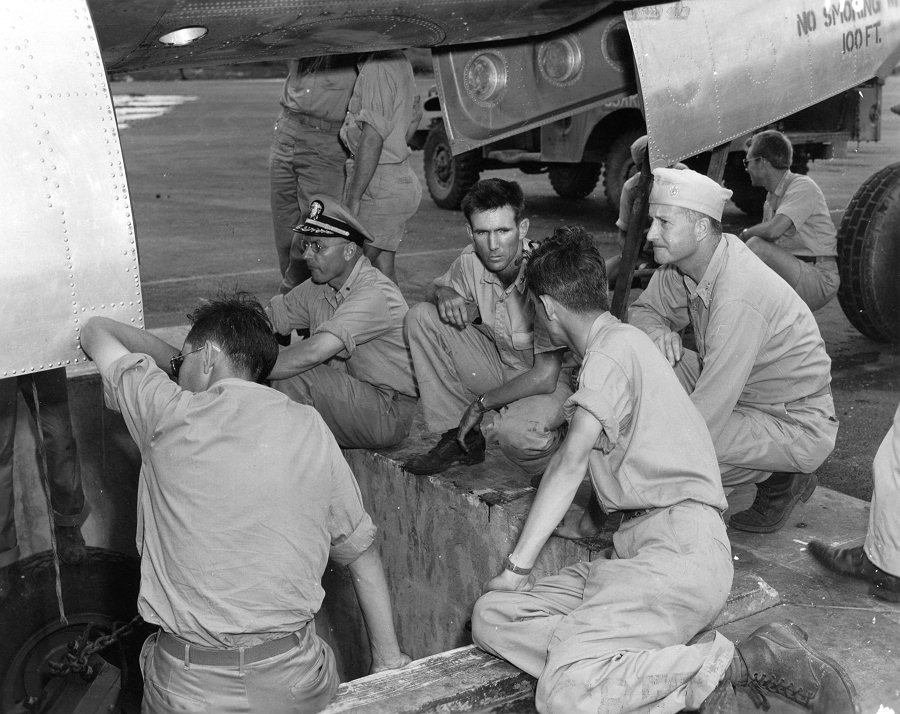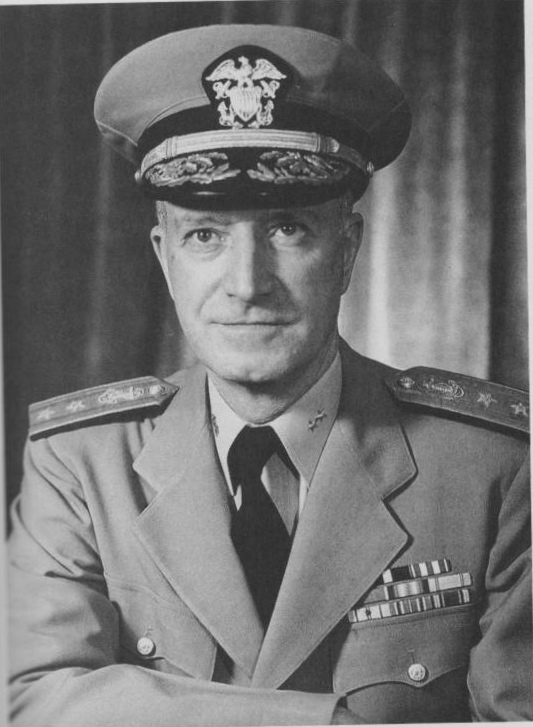“We’ve really caught a spy! A guy down here is trying to get in, and his uniform is as phony as a three dollar bill. He’s wearing the eagles of a colonel and claims that he is a captain.”
These were the words of the MP on guard when Captain William “Deak” Parsons arrived at Los Alamos in June of 1943. Parsons was the first naval officer to arrive on site, and it was understandably curious that he would be assigned to a scientific operation in New Mexico, a thousand miles from the nearest ocean. Despite his inauspicious welcome, Parsons soon proved himself an invaluable member of the Manhattan Project, bringing both organizational skills and ordnance expertise.
Naval Research Laboratory
Parsons showed his ability to work closely with both scientific and military personnel long before he joined the Manhattan Project. As a young naval officer, Parsons was reassigned to the United States Naval Research Laboratory (NRL). When he heard about experimental high-frequency radio observations taken by A. Hoyt Taylor, head of the Radio Division at NRL, Parsons immediately understood their military possibilities and promoted further research into radar.
Nevertheless, neither the Navy Bureau of Engineering nor the Naval Research Laboratory were interested in pursuing this research. Parsons recalled that the idea was “treated as a wild dream with practically no chance of real success.” While he had difficulty persuading the Navy it was important, Parsons nevertheless managed to convince NRL scientists and radio engineers that such a project could be crucial for the future. His colleague Dr. Ross Gunn recalled, “Parsons pursued [radar] as a ‘boy’s dream,’ that is, with great fervor and lack of discouragement.”
After the outbreak of World War II, Parsons served at the Naval Proving Grounds in Dahlgren, Virginia and at the Applied Physics Laboratory in Silver Spring, Maryland, where he worked on the development of proximity fuzes for antiaircraft guns. As he had done at the Naval Research Laboratory, Parsons gained a reputation as an officer who could work well with scientists.
In 1943, Manhattan Project director General Leslie Groves was seeking a chief ordnance officer for the Los Alamos laboratory. “I think Groves asked Vannevar Bush for his suggestion,” Peggy Bowditch, Parsons’s daughter, told the Atomic Heritage Foundation in a 2013 interview. “First, of course, being an Army base, they wanted an Army ordnance expert, but Bush said, ‘The guy you need is Parsons.’”
Manhattan Project
In June of 1943, Parsons arrived at Los Alamos. His wife, Martha, and their children, Peggy and Clare, joined him.
An initial problem for the Los Alamos site was whether it would be a military or civilian project. General Groves initially wanted the scientists in uniform but the scientists strongly opposed this idea. Parsons became an intermediary between the military and civilian sides of the project, respected by both Groves and Los Alamos laboratory director J. Robert Oppenheimer.
Groves lauded Parsons as having an “understanding of the interplay between military forces and advanced scientific theory.” In an interview with Parsons biographer Al Christman, Groves added, “He didn’t think about his uniform very much. Of course, when others did they thought, ‘He’s Navy and not Army.’ Parsons was able to do certain things for me without being disloyal to Oppenheimer.”
Indeed, the Parsons family maintained a close relationship with the Oppenheimer family. Parsons and his family lived next door to the Oppenheimers on Bathtub Row, and Peggy would occasionally babysit Oppenheimer’s son Peter. Peggy recalls that Kitty Oppenheimer and Martha Parsons were particularly close: “She rode a lot with Kitty Oppenheimer. They were a good pair, quite different, but they both loved riding. I think Kitty liked the fact that my mother was a take-charge type.”
As leader of the Ordnance Division, Parsons was initially entrusted with overseeing the assembly of the gun-type uranium bomb. After the Los Alamos laboratory’s August 1944 reorganization, Parsons was named associate laboratory director and was assigned the task of transforming the designs for both the uranium and plutonium bombs into combat weapons. Parsons stressed the importance of reliability and safety over durability in the bombs’ designs.
While Parsons had his share of disagreements with colleagues at Los Alamos, he was respected as a strong leader. Scientist Norris Bradbury remembered, “Parsons was firm, but never to my knowledge, arbitrary. One of his virtues was that he focused on those things he knew about. He would press his points on weapon feasibility, military practices, and ordnance tests, but not in areas in which he was not knowledgeable.”
Project Alberta
In March of 1945, Parsons took charge of Project Alberta, which was responsible for planning and carrying out all the necessary steps for the bombs’ combat use. This process included overseas operations at Tinian Island in the Pacific for the assembly and delivery of both bomb types. Before Parsons left for Tinian, Groves ordered, “Don’t let Parsons get killed. We need him!”
 Thanks in large part to Parsons’s organizational skills, the tasks on Tinian were accomplished with amazing speed: the bombs were ready to be deployed within three weeks of the Trinity test on July 16, 1945. Every stage was thoroughly considered and carefully organized. An accident in assembling the bomb or during takeoff would have been disastrous.
Thanks in large part to Parsons’s organizational skills, the tasks on Tinian were accomplished with amazing speed: the bombs were ready to be deployed within three weeks of the Trinity test on July 16, 1945. Every stage was thoroughly considered and carefully organized. An accident in assembling the bomb or during takeoff would have been disastrous.
Parsons’s responsibilities extended to the bombing missions themselves. On August 6, 1945, the Enola Gay departed for Hiroshima with Parsons on board as weaponeer. He was responsible for arming the “Little Boy” bomb in flight, as well as authorizing the release of the weapon over the Japanese city. Click here to read Parsons’s checklist for loading the charge into the bomb.
Peggy Bowditch described the mission as “a typical Parsons job. My father [made] every possible, well, worst-case scenario planning. And everything went like clockwork, partly because of the planning, and partly because of luck. He armed the bomb in flight and my father literally could not fix a leaking faucet. The irony of his doing that!”
Parsons was awarded the Silver Star for “gallantry in action” on the Hiroshima mission. Parsons was also awarded the Distinguished Service Medal for his work on the Manhattan Project. Oppenheimer commented, “It is impossible to overestimate the value which Captain Parsons has been to the project.”
Operation Crossroads, Death, and Legacy
With the war finished, Parsons returned to his work for the Navy, where he was promoted to Rear Admiral. He pushed for nuclear-powered ships and submarines, and was assigned to work on Shot Baker of Operation Crossroads in 1946, the world’s first underwater nuclear test.
Throughout this period, Parsons stayed in close contact with Oppenheimer. Peggy Bowditch remembered, “In December of ’53 my father heard at a cocktail party that Oppie had been separated from his Q [security] clearance. He was so upset that he came home and began a heart attack.” Parsons died shortly afterward, on December 5, 1953. He was 52 years old.
From radar to the atomic bomb, Parsons was on the front lines of recognizing and harnessing new technologies for military use. As Christman comments, “His is a life that reveals both lessons and cautions concerning the use of science for military purposes. It is the life of a new kind of warrior.”





